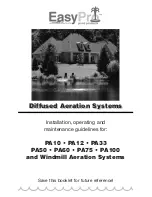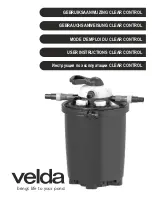
20
Arsenic Facts Sheet
Arsenic (As) is a naturally occurring contaminant found in many ground water sources. It generally occurs in two forms:
pentavalent arsenic (also known as As(V), As(+5) or arsenate) and trivalent arsenic (also known as As(III), As(+3) or
arsenite). In ground water, arsenic may exist pentavalent form, trivalent form or a combination of the two. While both
forms are potentially harmful to human health, trivalent arsenic considered more harmful than pentavalent arsenic. More
information about arsenic and its toxicity can be found on the USEPA website at
www.epa.gov/safewater/arsenic.html
Note: This system is designed to remove only pentavalent arsenic. This treatment system does not provide a feature for
conversion of trivalent arsenic to pentavalent arsenic. This system may remove some trivalent arsenic, however, it has
not been formally evaluated for its ability to remove trivalent arsenic.
Trivalent is generally more difficult to remove from drinking water than pentavalent arsenic. Trivalent arsenic can be
converted to pentavalent arsenic in the presence of a strong oxidant such as free chlorine. The arsenic in water containing
detectable free chlorine or treated with another strong oxidant such as ozone will be in the pentavalent from. Treatment
with chloramine (combined chlorine) is not sufficient to ensure complete conversion of trivalent arsenic to pentavalent
arsenic.
Consumers using public water supplies can contact their utility to verify whether free chlorine treatment is being used.
Private water supplies that do not have detectable free chlorine residuals should be analyzed to determine the presence
and form of arsenic which will determine if pretreatment with free chlorine is needed or not.
Arsenic does not generally impart color, taste or smell to water, therefore, it can only be detected by a chemical analytical
test. Public water supplies are required to monitor treated water for total arsenic (trivalent plus pentavalent forms) and
the results are available to the public from the utility. Consumers using private water sources will need to test their water.
It is recommended that the test be conducted by a certified laboratory. Your local health department can provide a
recommendation for a certified laboratory. Some laboratories can analyze the sample for both forms of arsenic
individually as well as total arsenic if requested.
This treatment system was tested under laboratory conditions by the National Sanitation Foundation (NSF) as defined by
the NSF/ANSI 58 Reverse Osmosis Drinking Water Systems standard and was found to reduce 0.29 mg/L of arsenic in the
test water to 0.002 mg/L, under standard testing conditions. Actual performance of the system may vary depending on
specific water quality conditions at the consumer’s installation. Following installation of this system, the consumer should
have the treated water tested for total arsenic to verify arsenic reduction is being achieved and the system is function
properly.
The component in this system that removes pentavalent arsenic must be replaced at the end of its useful life at
approximately 24 months. This replacement component, the RO membrane, is part number AC-OM-75-FILMTEC and can
be purchased online, at a Hankscraft Elements dealer or directly from Hankscraft. It is critical to maintain the quality of this
drinking water systems by using only genuine Elements by Hankscraft replacement parts. Replacement parts supplied by
other manufactures will not fit properly, function properly and will place the user at risk of drinking contaminated water
and potential damage of property due to leaks.


































